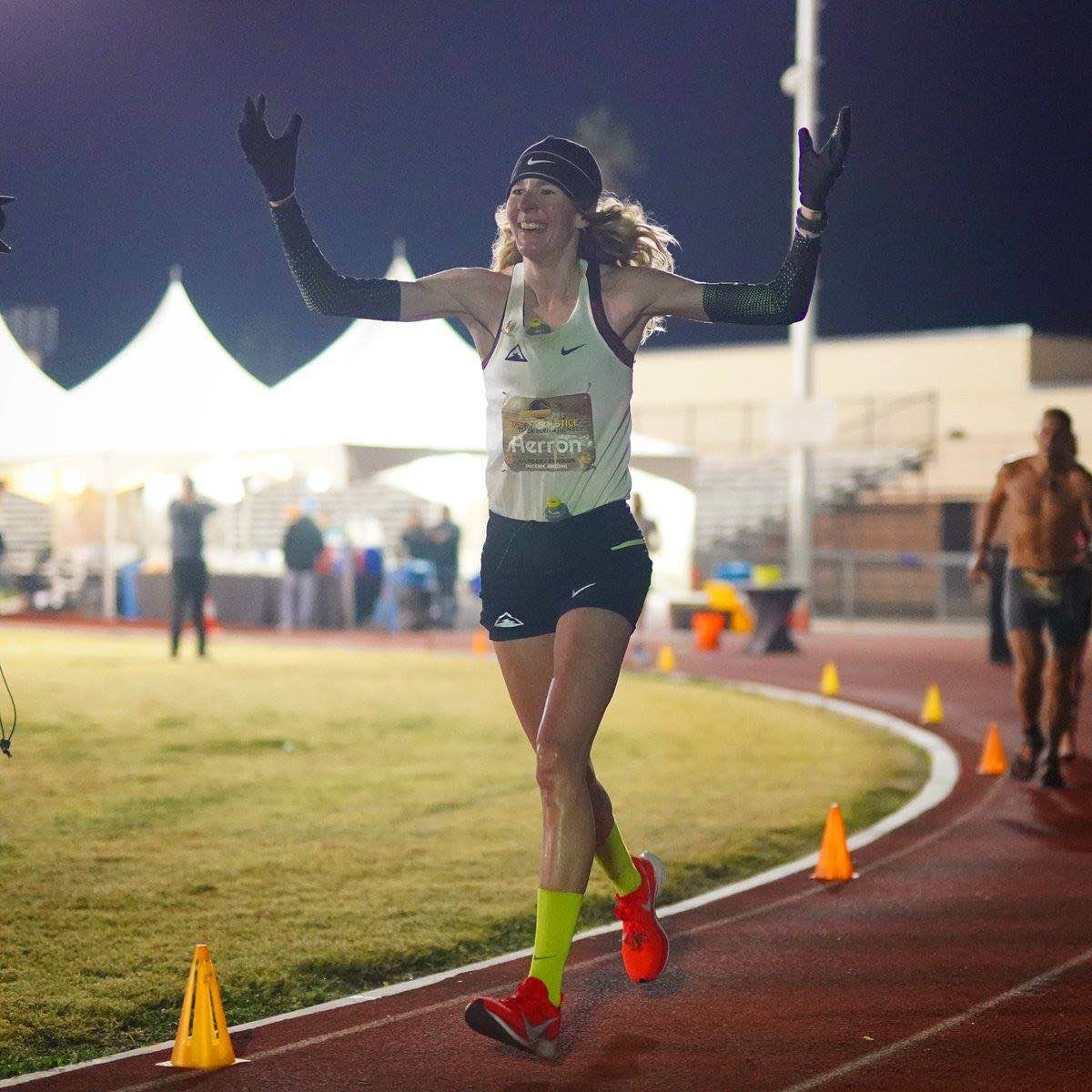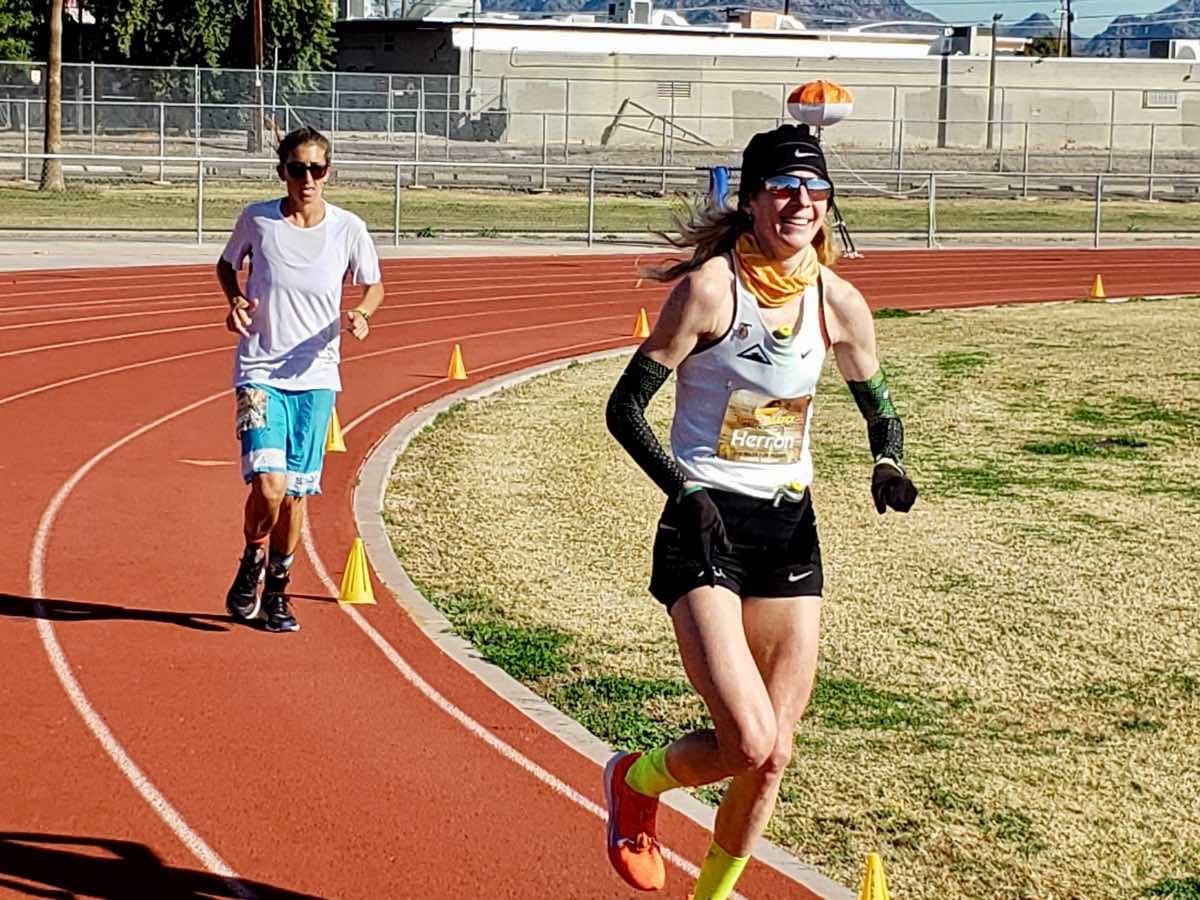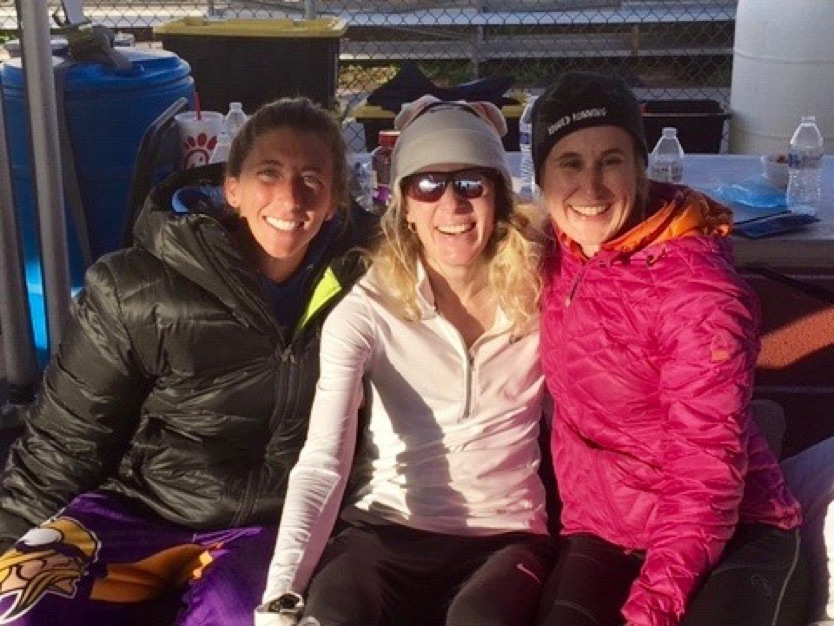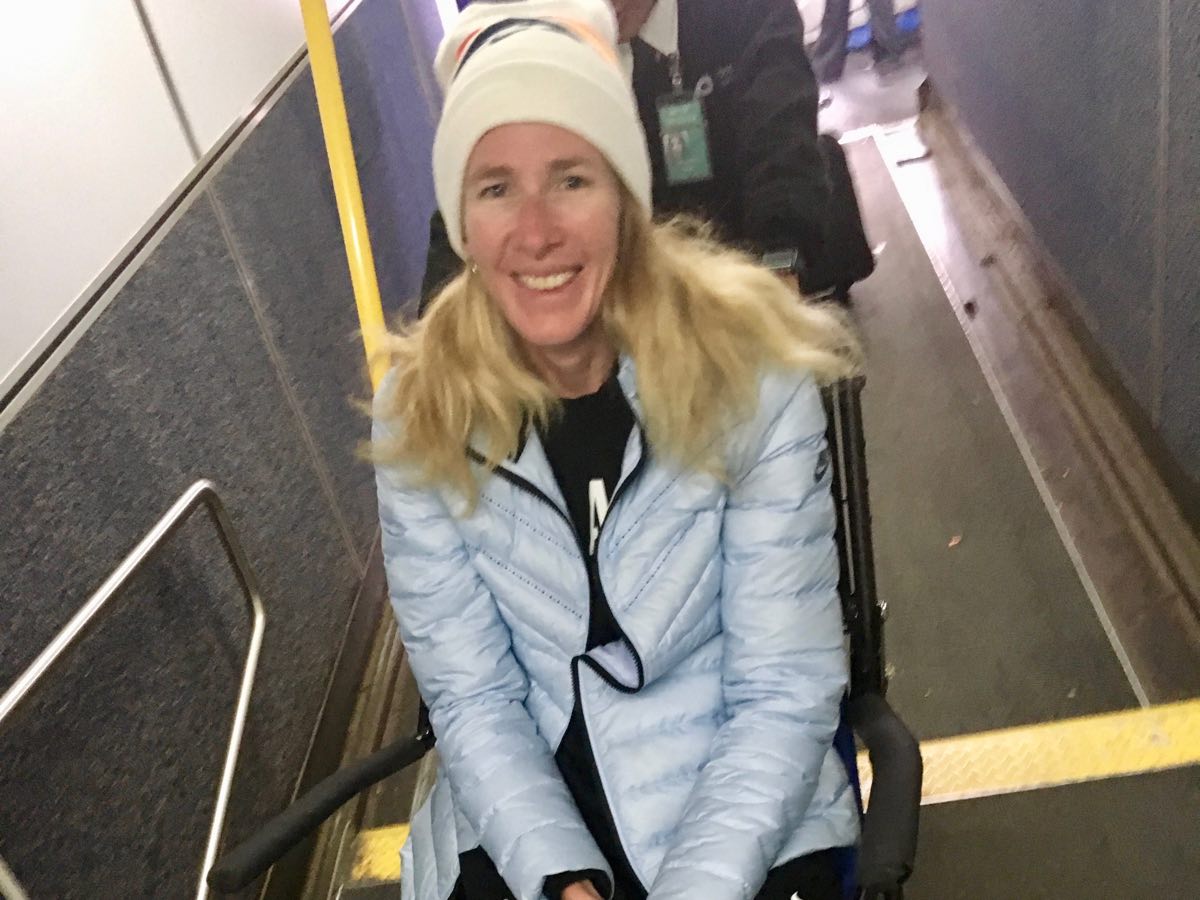Camille Herron ran 162.919 miles to set a new 24-hour world record at the 2018 Desert Solstice Track Invitational, along with achieving American records for 100 miles on a track and 200 kilometers in the process. The previous 24-hour world record of 161.550 miles was set in 2017 by Poland’s Patrycja Bereznowska. In this interview, Camille talks about the year leading up to this race which was filled with highs and lows, her 24-hour pacing strategy, her shoe choices and how her feet held up for 24 hours on a track, how she ate Taco Bell when feeling poorly in the middle of the night, and what it was like to achieve this goal.

Camille Herron on her way to setting a new 24-hour world record at the 2018 Desert Solstice Track Invitational. Photo: Aravaipa Running/Howie Stern
iRunFar: It’s 10:30 a.m. on Tuesday and you’re in bed with your coffee. You posted a photo on social media yesterday of you in a wheelchair at the airport. How are you feeling physically? [laughs]
Camille Herron: [laughs] It was pretty rough yesterday. I could barely move. I was able to get out of bed better today, so I’ll just take it in baby steps. My right hip flexor is really sore. I’m probably going to lose two toenails, but my feet are pretty darn good considering how far I went.
iRunFar: One world record and two American records—how are you feeling mentally right now?
Herron: I was just telling my husband Conor [Holt] that my brain and legs feel like Jell-O. I actually had to put my thoughts down on paper so I could focus. I’m really tired.
iRunFar: The physicality of running is obvious, but there’s such a mental component to it also.
Herron: Yeah, definitely.
iRunFar: I want to back up a bit and talk about the last year. We last interviewed you after your 100-mile world record at the Tunnel Hill 100 Mile, a little over a year ago. You’ve ridden a roller coaster since then. Hindsight is always 20/20, so what’s your vision on the last year?
Herron: Yeah, I did so many amazing things in 2017, but I was also pretty tired. Going into 2018, it just seemed like it was one thing after another. I just had to shut it down.
I was doing really good going into the 2018 Comrades Marathon and the Western States 100. My training was going really well up to that point. I had a regular strength routine, and I tried to do some random exercise and pulled a muscle in my right quad. Within a couple days, I couldn’t run at all. I’d strained the quad and developed a stress reaction in the femur. This was maybe a week and a half before Comrades. In a couple days, I went from having one of my best workouts ever to being unable to run.
My doctor was originally pretty optimistic, saying I could back off for a week and maybe give up Comrades and then run Western States. I tried to remain optimistic too, but I realized I was badly limping and in too much pain two weeks later. We scrapped it all. I still feel really fortunate that I’ve gone my whole adult career not having a major injury until this. This is the longest I’ve rested since I was 19. I used this year to let my body and mind rest.
We had to have a long view as the picture for the year. Looking at the rest of the year, I signed up for Desert Solstice in July before I’d started running again.

Camille Herron and Courtney Dauwalter running at the 2018 Desert Solstice Track Invitational. Photo: Chris Worden
iRunFar: Let’s talk about your decision to race 24 hours at Desert Solstice. You were there last year and you raced for 12 hours. This year you decided to double the time? No big deal? [laughs]
Herron: [laughs] From talking to other people who do this event, one of the things was that you have to commit to the full distance. You have to be mentally and physically committed to that. Last year, I was pretty optimistic having seen people like Ann Trason and Pam Smith who have done 100 miles and continued on for the whole 24 hours, but that 12-hour record I hit last year, it was hard–really hard. I give credit to Ann Trason because that was a really tough record. It took everything I had to get it.
For me to make 24 hours, I had to commit and mentally and physically wrap myself around how to keep going for the extra 12 hours and the push through the night. It’s been a year in the making to prepare myself for that.
iRunFar: You’d done several races in the realm of 12 to 13 hours, but to double that and compound the complexities of night running and staying awake and the nutrition and circadian rhythms, it had to feel pretty intangible. Was it hard to envision how it would come together?
Herron: It was. Conor and I have planned for the past year. I tried for the record in the spring at a 24-hour event in Oklahoma. I’ve made a lot of mistakes at 100 miles and below. I took all the mistakes I’ve made previously, and thought about what I could possibly experience going overnight. Everyone told me that when you hit 18 hours, that’s the point people kind of start to break down. I was anticipating a bear jumping on my back at 2 a.m.
I’m a science person, so I took my own scientific knowledge and what I’ve learned from others and the issues they’ve had to overcome. We went into it with a plan that whatever roadblocks I encounter, I just have to troubleshoot and try to push through them.
My support team was Conor, and my friends Kevin and Gretchen, and we had a plan how we were going to troubleshoot. We thought about my nutrition. I normally take gels and sports drinks and soda and beer. I’m not someone who takes in solid foods, but maybe the longer I go, maybe I need to be taking in more solid foods. Gretchen ran to Taco Bell and got some double-decker tacos. I had three pairs of Nike VaporFly and Pegasus Turbo shoes. We just tried to be as prepared as possible.
iRunFar: I want to pick your brain about your pacing strategy. You were going after the 24-hour world record that was held by Patrycja Bereznowska, which I think works out to about 8:54 minutes/mile pace. For somebody like you, that is creeping along. But yet, it’s a pace you have to figure out how to maintain for 24 hours, and that seems so hard. There’s a long history of people competing at 24 hours with multiple strategies yielding success. How did you strategize maintaining that pace for 24 hours?
Herron: I approached it like Yiannis Kouros, where he would basically bank miles in the first 100 miles or so. Then in talking to my friends at the 24-hour events, they said there’s a natural slow down in pace overnight. I said, okay, I’m going to approach it in thirds. The first two-thirds is like the 100 miles, and the last third is the 63 miles or whatever.
I planned to run at 65 to 70% of heart-rate max effort, which is low-8:00 minutes/mile pace for the first 100 miles. I was pretty perfect with that part. I thought I’d hit 100 miles between 13 hours and 13:30. I hit the 100 miles in 13:25, and I felt great.
It was really important to me to go the full 24 hours. I wanted to run the full distance. I needed to experience running through the night. I felt like I had a more conservative approach than I normally would where I’m gunning it for the entire distance. I purposely slowed down my pace after 100 miles. I tried to slow down to 8:30 to 9:00 pace.
Also, I had competition with Courtney Dauwalter and Pat Reagan and Zach Bitter. As we kept going, they fell off. Not having that competition around me, maybe it didn’t drive me to push as hard as I otherwise would have, but I felt like once they started to fall back, it was more about doing what it takes to get through the night and maintain my body and my nutrition. It became more a race against myself.
iRunFar: Can we talk about shoes? Nike VaporFlys for 24 hours seems like kind of a risk. [laughs]
Herron: [laughs] I have to give credit to Nike because I’ve had the new VaporFlys since last spring. I have pretty bony feet that are really long and narrow. I need a pretty soft upper. When they sent me the Flyknit VaporFly, it worked a lot better for my feet. I was really excited to use them for Desert Solstice. I do a lot of training in that shoe. I train almost exclusively in racing flats, so I’m really comfortable with the shoes that I race in since they’re the shoes I train in. Biomechanically, I’m very efficient in that shoe. Yeah, I had two pairs of VaporFlys and a pair of Pegasus Turbos as a back-up. I ended up using all three pairs.
iRunFar: When did you switch into the second pair of VaporFlys?
Herron: I could feel a blister on my left foot that popped at one point, but otherwise, my feet felt great for 14 or 15 hours. Then it felt like I had a rock on the top of my shoe. I don’t know if the repetitiveness of the track did something to the top of the shoe, but it started to bunch up in one place and I developed a hotspot on the top of my foot. I tried to re-tie my shoe but I could still feel the hotspot, so I changed to my second pair of VaporFlys. I went for five more hours in the second pair, but I was still feeling some pain on the top of my foot and in my arch. I changed to the Pegasus Turbo, which has a completely different upper and is a softer shoe. That’s the shoe that got me to the finish.
iRunFar: Amazing. You mentioned the competition. Courtney Dauwalter was out there. She’s was the 24-hour world-record holder before Patrycja. She’s a proven quantity at these ultra-long distances. Can you talk about that aspect of competition and camaraderie?
Herron: The cool thing about a track ultra and especially going for 24 hours is that it’s a very intimate and shared experience with the 30-plus other competitors. You’re not on the trails by yourself; you’re together on a track. You’re coming and going and passing. You’re running with people and chatting and laughing. You feel each other’s highs and lows. You see people puking and going to the restroom and ending their races. That was probably my favorite part of this experience. You’re feeling for all the other competitors. You’re cheering each other on. I was really feeling for Zach and Pat and Courtney. When they stopped, I felt deflated for them. I hoped they were okay.
iRunFar: Online race observers talked about a volatile period in the night where you stopped running, walked, ate some food, and eventually got running again. Was that time volatile from your perspective? Is this where the Taco Bell eating and beer drinking took place?
Herron: I hit a point at 2 or 3 a.m. where I started feeling dizzy and low energy. I think it was just going through that period where your body wants to sleep. This is the first time I’ve ever done this. I basically walked a couple laps with a taco and beer and I put on the extra shirt because it was cold.
It took all this mental will to get my legs moving again. Once I got my legs running again I improved my pace and got down to 2:20 or 2:30 per lap. My right hip flexor was really tight and I just could not go any faster. I was trying to push the pace back down to 9:00-minute pace, but I couldn’t go any quicker than 10:00-minute pace.
It was really hard for me to imagine five or six hours running at 10-plus-minute miles, but my crew told me that all I had to do to hit the world record was 10:40- to 11:00-minute miles. I just tried to keep myself mentally engaged and concentrate on 2:30 to 2:40 per lap splits.
This is where I really started to think about my good friend, David Manguno. He was a local runner here in Oklahoma and like the real Forrest Gump. He was this guy that would put in 7,000 miles per year running. He passed away six weeks ago and we felt a huge loss with his passing. We used to see him all the time out running by our house. He was my inspiration for this race. I felt like he was with me in spirit. When I hit that dark moment at 2 or 3 a.m., I just had to remain positive and be inspired by David and keep going.
iRunFar: I watched the online feed for the last couple hours. When I saw you running, I thought, She looks like she’s in pain now. Was it feeling rough in the last couple hours?
Herron: Yeah, my legs were like rocks and my right hip flexor was so tight. It was all about keeping moving forward and getting to 8 a.m. when the race ended.
iRunFar: In the end, you surpassed the world record with about 15 minutes to go. It was kind of close, but also not close. Fifteen minutes seems like a lot of time and a little time. What was going through your mind? Can you transport us to that moment?
Herron: Conor was giving me updates, and I knew I should hit the world record with 15 to 20 minutes to go if nothing happened. I just hoped nothing would go wrong, no need for a bathroom break, or passing out, or something crazy. Ultras are crazy like that. I was telling myself to stay in cruise control and concentrate.
The cool thing about a track race is that we’re pretty accessible to everyone. There were people coming and going all day to spectate. It was really neat to see people bringing out their kids to come see us. People started gathering around the track, anticipating this moment.
I got really, really excited. I had a smile on my face for the entire 24 hours pretty much because it was such a cool experience. Since I got into ultrarunning, I’ve wanted to go for these records. To finally realize this moment, it was just like, “YES!”
iRunFar: So very sweet but then kind of mean because there were still 15 minutes left in the race? [laughs]
Herron: [laughs] Yeah. They asked me if I was going to stop, but I was like, “No, I’m going to keep going to try to get an extra mile and a half if I can.”
iRunFar: That’s awesome. It may also be kind of mean to ask this question when your goal today might be to stay out of bed for two hours or something, but have you started dreaming of next year?
Herron: I’m getting to the point where I’ve reached almost all my goals as a road and track runner. We bought a house in Alamosa, Colorado this year, so that was one of our big transitions, to prepare for the rest of my running career. I want to transition to trail running and go after all these trail running goals I have. I want to be able to prepare as best as I can to transition more to adventure running and trail running.
I still want to win the Comrades/Western States double, which only Ann Trason has done. She set the bar really high, and I want to go after that feat and try and see if I can achieve that as well. Next year I am committed to this goal.
Looking farther ahead, I want redemption. I want to prove I can run on trails because I know I can. I’ve just had really bad mishaps kind of comparable to Ann Trason at the beginning of her running career. She had two DNFs at Western States, and I think she had a DNF at the Leadville Trail 100 Mile. It took her time to become a better trail runner as her career evolved. I want to follow in her footsteps and become a better trail runner. I want to go back to Leadville. I’ll try to go after her course record there next year.
Then, yeah, I’m super stoked I made the U.S. 24-hour team. We have such an amazing ladies team for next year. We’ve got me and Courtney and Katalin Nagy and, gosh, such an amazing team. I’m really looking forward to trying to win the team title at the 24-Hour World Championships.

Left to right is Courtney Dauwalter, Camille, and Pam Smith after the race. Pam was at the race as crew this year. Photo: Conor Holt
iRunFar: That’s a big year. There’s a lot there. You have four big goals.
Herron: Yeah, pretty much. I feel like I’ve met a lot of my goals at road races, and I just want to prove I can run on the trails and redeem myself. That’s how I feel about going into Western States next year and going into Leadville. I’ve got to learn how to maintain my intensity, overcome roadblocks, and troubleshoot. I think we’re getting better and learning how to troubleshoot. It’s just a process in learning how to become a trail runner. I really appreciate the journey of trying to go from something I’m very comfortable with as a road racer to become better as a trail runner.
iRunFar: Spending a lot of time at the edge of or just over the edge of your comfort zone?
Herron: Yeah, definitely.
iRunFar: Congratulations, Camille, and thanks so much for the interview.



